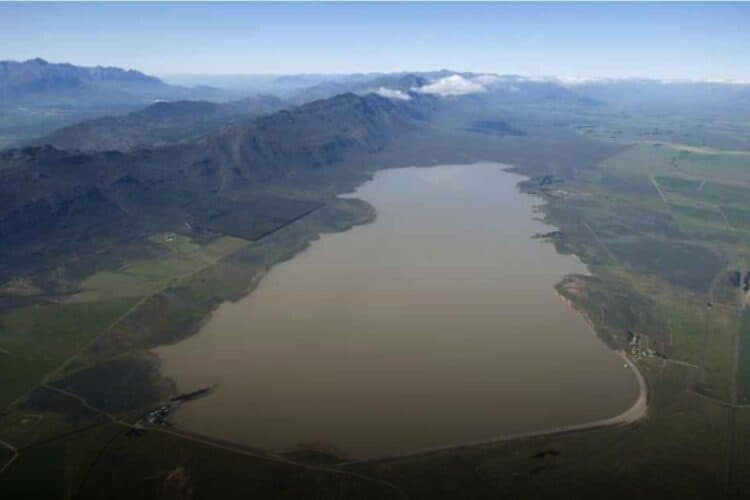Cape Town dam levels experienced a decrease to 68.5% on Monday, 18 March 2024, a 1.90% drop from a week ago.
Cape Town dam levels drop to 68.5% on Monday, 18 March 2024
Despite the early winter rains surpassing average expectations, the city’s water resource status is currently set to “Wise Water Use,” with levels expected to drop to 60% before the rainy season, which is anticipated to kick off in May 2024.
Cape Town’s daily average water consumption rose 4.1% from approximately 914 million litres last week to 954 million litres on Monday, 18 March 2024, sourced predominantly from major dams, with minor contributions from groundwater, springs, and minor dams.
A look at changes in major dams
Among the city’s major water reservoirs, fluctuations were observed in the past week.
The Berg River Dam, a significant water source, recorded a slight decrease from 75.7% to 74.6%. The Steenbras Lower Dam also witnessed a reduction, moving from 63.7% to 62.9%.
Notably, the Steenbras Upper Dam’s level decreased from 90.8% to 88.4%. The largest dam, Theewaterskloof, showed a significant dip from 69.3% to 67.1%, whereas Voëlvlei and Wemmershoek recorded levels of 62.9% and 75.5%, respectively.
Here’s a look at the major Cape Town dam levels as of Monday, 18 March 2024:
| Dam | % Full This Week | % Full Last Week | % Change |
|---|---|---|---|
| Berg River | 74.6% | 75.7% | -1.1% |
| Steenbras Lower | 62.9% | 63.7% | -0.8% |
| Steenbras Upper | 88.4% | 90.8% | -2.4% |
| Theewaterskloof | 67.1% | 69.2% | -2.1% |
| Voëlvlei | 62.9% | 64.4% | -1.5% |
| Wemmershoek | 75.5% | 77.2% | -1.7% |
Cape Town minor dams weekly changes
In contrast to the major dams, minor dams in the Cape Town area presented a varied performance over the last week.
Overall, these smaller reservoirs experienced a collective decrease in their fill levels, moving down 0.25% from last week to an aggregate of 46.9%.
Notable changes include the Hely-Hutchinson Dam on Table Mountain, which saw a slight rise from 7.3% to 7.4%. The Land-en-zeezicht Dam also improved, reaching 93.2% from 91.5%.
Despite these gains, some dams like the Lewis Gay and Kleinplaats experienced slight decreases in their levels.
| Dam | % Full This Week | % Full Last Week | % Change |
|---|---|---|---|
| Alexandra | 37.1% | 38.1% | -1.0% |
| De Villiers | 96.4% | 96.7% | -0.3% |
| Hely-Hutchinson | 7.4% | 7.1% | +0.3% |
| Kleinplaats | 53.5% | 54.2% | -0.7% |
| Land-en-zeezicht | 93.2% | 91.5% | +1.7% |
| Lewis Gay | 28.1% | 30.8% | -2.7% |
| Victoria | 70.4% | 72.0% | -1.6% |
| Woodhead | 44.9% | 45.1% | -0.2% |
Five easy ways to save water and reduce consumption
Here are five effective ways to achieve this goal:
- Fix Leaks Promptly: A small drip from a leaking faucet or pipe can waste a significant amount of water over time. Regularly checking for and repairing leaks in plumbing fixtures, irrigation systems, and pipes can prevent water wastage.
- Install Water-Efficient Fixtures: Using low-flow showerheads, faucets, and toilets can significantly reduce water usage. These fixtures are designed to use less water while maintaining efficiency, which can lead to considerable savings on water bills and a substantial reduction in water consumption.
- Practice Efficient Watering: Watering lawns and gardens can consume a large amount of water. Watering during the early morning or late evening reduces evaporation and ensures that plants receive the moisture they need. Employing drip irrigation systems and soaker hoses targets water directly to the roots where it’s most needed, reducing waste.
- Use Water-Saving Appliances: Choosing appliances like dishwashers and washing machines that are energy and water-efficient can lead to substantial water savings. These appliances are designed to use minimal water while delivering optimal performance. Running them only when full maximizes efficiency and conserves water.
- Adopt Water-Saving Habits: Simple daily actions can lead to significant water savings. Turning off the tap while brushing teeth, shaving, or washing dishes by hand, and taking shorter showers are practical habits that reduce water use. Additionally, collecting rainwater for garden irrigation and using a broom instead of a hose to clean driveways and sidewalks can further decrease water consumption.






